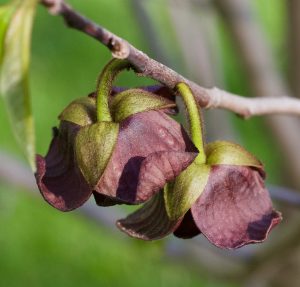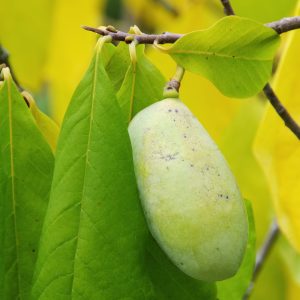 Pawpaw trees are growing in popularity for a number of reasons. First, the trees look amazing in landscape settings with their lush green leaves and tropical look. Next, they provide green fruit with a custardy flesh that resembles a creamy dessert. We find the lush sweet inside tastes like bananas mixed with mango and a dash of vanilla. They’re high in vitamin C and antioxidants, plus a source of other beneficial nutrients. What more can you ask from a tree?
Pawpaw trees are growing in popularity for a number of reasons. First, the trees look amazing in landscape settings with their lush green leaves and tropical look. Next, they provide green fruit with a custardy flesh that resembles a creamy dessert. We find the lush sweet inside tastes like bananas mixed with mango and a dash of vanilla. They’re high in vitamin C and antioxidants, plus a source of other beneficial nutrients. What more can you ask from a tree?
Ethan, our farm’s tree guru, enjoys pawpaw ice cream, smoothies, chiffon pie and a delicious pudding dish he makes using his harvested fruits. We’ll feature a few of his favorite recipes when our fruit is ready to eat. If you like to read, Ethan recommends a book by Andrew Moore, called Pawpaw, In Search of America’s Forgotten Fruit.
 Lately, this fruit is getting a lot of attention but it’s hard (almost impossible) to find at your local grocers. Maybe you’ll get lucky and locate them at a farmer’s market. Consider obtaining your pawpaws like many fans by gathering the fruits in the wild. Our choice at Clifton Hall Farms is to GROW THEM. They’re easy to grow and the largest edible fruit that’s indigenous to North America you’ll find. The neighbors will be impressed.
Lately, this fruit is getting a lot of attention but it’s hard (almost impossible) to find at your local grocers. Maybe you’ll get lucky and locate them at a farmer’s market. Consider obtaining your pawpaws like many fans by gathering the fruits in the wild. Our choice at Clifton Hall Farms is to GROW THEM. They’re easy to grow and the largest edible fruit that’s indigenous to North America you’ll find. The neighbors will be impressed.
Most pawpaw trees have perfect flowers, which are bisexual flowers that contain both male and female reproductive parts on the same flower. Some pawpaw trees have female flowers, others have male flowers and yes, there are trees with both male and female flowers. We recommend that you plant a minimum of two trees to help ensure pollination. It may be difficult to know in advance if your tree will have flowers that self-pollinate.
We purchase most of our pawpaw trees from online nurseries. Our favorites are:
Pawpaws can grow 20 to 40 feet tall and are typically found in wooded areas as an under story tree. We find that our trees grow fine in shade, partial shade and full-sun on our farm, basically anywhere. Can it get any easier? You have to admit, this is a very flexible tree that can fit into most yards and gardens without any concerns.
- Latin name is Asimina Triloba.
- Hardiness zons 5-9.
- Requires a long, warm summer to ripen fruit.
- Plant a minimum of two trees.
- Plant at least 10 feet apart.
- Water new trees regularly but don’t overwater.
- Good soil drainage is recommended.
- Thrives without pesticides or herbicides.
- Certain species of flies and beetles pollinate trees.
- Pawpaw fruits fall from the tree when ripe.